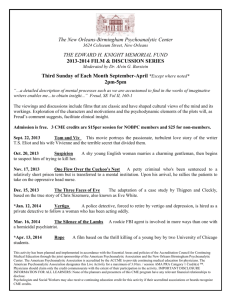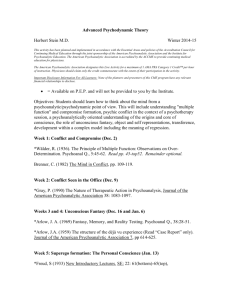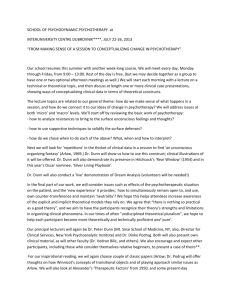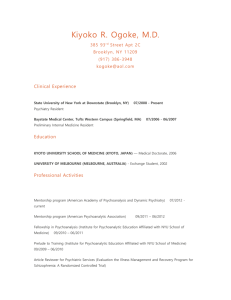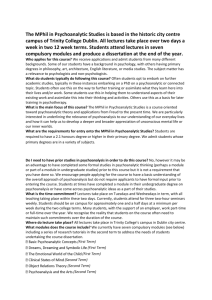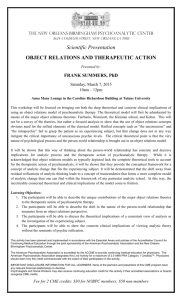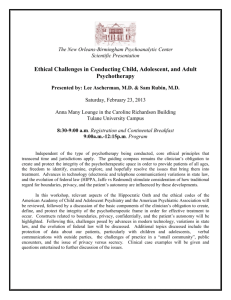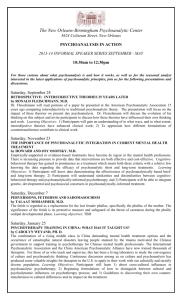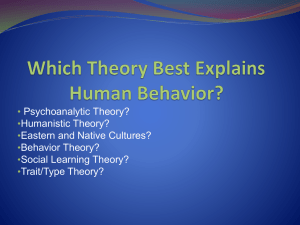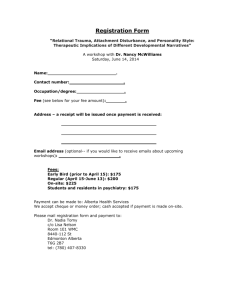Psychoanalytic Theory and Therapy - Argosy University Dissertation
advertisement
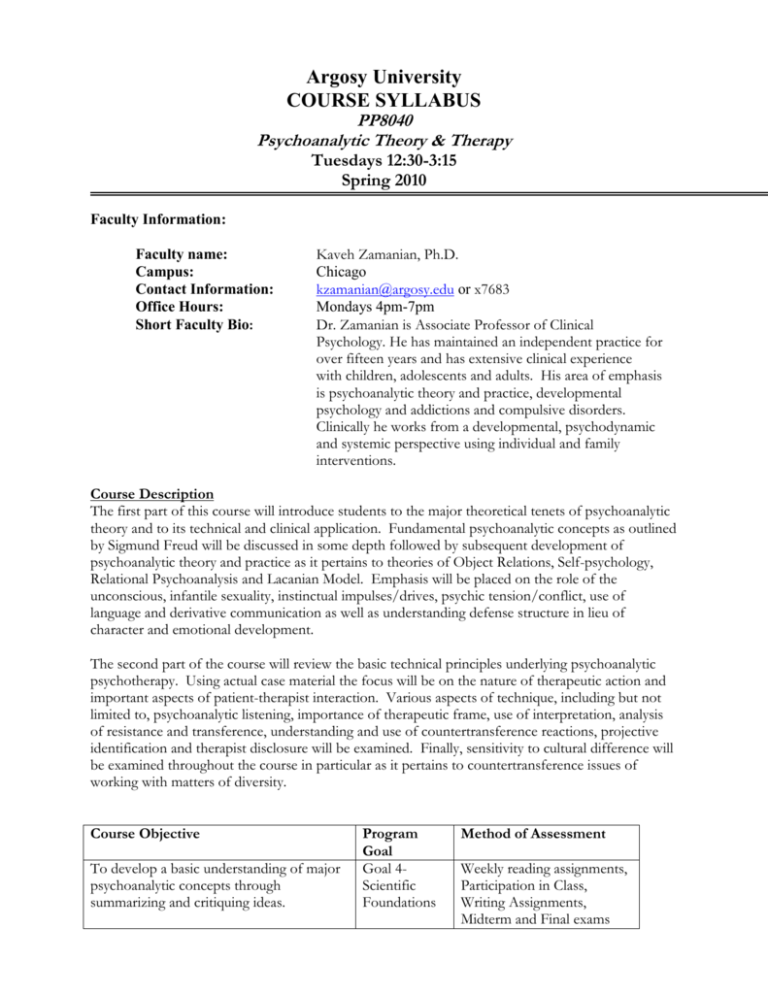
Argosy University COURSE SYLLABUS PP8040 Psychoanalytic Theory & Therapy Tuesdays 12:30-3:15 Spring 2010 Faculty Information: Faculty name: Campus: Contact Information: Office Hours: Short Faculty Bio: Kaveh Zamanian, Ph.D. Chicago kzamanian@argosy.edu or x7683 Mondays 4pm-7pm Dr. Zamanian is Associate Professor of Clinical Psychology. He has maintained an independent practice for over fifteen years and has extensive clinical experience with children, adolescents and adults. His area of emphasis is psychoanalytic theory and practice, developmental psychology and addictions and compulsive disorders. Clinically he works from a developmental, psychodynamic and systemic perspective using individual and family interventions. Course Description The first part of this course will introduce students to the major theoretical tenets of psychoanalytic theory and to its technical and clinical application. Fundamental psychoanalytic concepts as outlined by Sigmund Freud will be discussed in some depth followed by subsequent development of psychoanalytic theory and practice as it pertains to theories of Object Relations, Self-psychology, Relational Psychoanalysis and Lacanian Model. Emphasis will be placed on the role of the unconscious, infantile sexuality, instinctual impulses/drives, psychic tension/conflict, use of language and derivative communication as well as understanding defense structure in lieu of character and emotional development. The second part of the course will review the basic technical principles underlying psychoanalytic psychotherapy. Using actual case material the focus will be on the nature of therapeutic action and important aspects of patient-therapist interaction. Various aspects of technique, including but not limited to, psychoanalytic listening, importance of therapeutic frame, use of interpretation, analysis of resistance and transference, understanding and use of countertransference reactions, projective identification and therapist disclosure will be examined. Finally, sensitivity to cultural difference will be examined throughout the course in particular as it pertains to countertransference issues of working with matters of diversity. Course Objective To develop a basic understanding of major psychoanalytic concepts through summarizing and critiquing ideas. Program Goal Goal 4Scientific Foundations Method of Assessment Weekly reading assignments, Participation in Class, Writing Assignments, Midterm and Final exams To formulate hypotheses about personality, relationships and a range of contextual factors on human behavior utilizing Freudian and Neo-Freudian approaches. Goal 1Assessment Goal 2Intervention Goal 3Diversity Weekly reading assignments, Participation in Class, Writing Assignments, Midterm and Final exams To learn about the listening process from a psychoanalytic perspective including how meaning is developed in the therapeutic process. Goal 1Assessment Goal 2Intervention Goal 3Diversity Weekly reading assignments, Participation in Class, Writing Assignments, Midterm and Final exams To formulate hypotheses about intrapsychic and interpersonal patterns and their adaptive and maladaptive impacts in significant life and therapeutic relationships. Goal 1Assessment Goal 2Intervention Goal 3Diversity Goal 1Assessment Goal 2Intervention Goal 3Diversity Goal 2Intervention Goal 3Diversity Goal 5Scholarship Weekly reading assignments, Participation in Class, Writing Assignments, Midterm and Final exams To apply these ideas to the practice of psychoanalytic psychotherapy. To integrate contextual factors related to human diversity into the application of psychoanalytic perspectives. Weekly reading assignments, Participation in Class, Writing Assignments, Midterm and Final exams Weekly reading assignments, Participation in Class, Writing Assignments, Midterm and Final exams Required Reading Casement, P. (1991). Learning from the Patient. Guilford Press. (ISBN: 0-89862-157-7). Fonagy, P. & Target, M. (2003). Psychoanalytic Theories: Perspectives from developmental psychopathology. New York: Routledge. (ISBN: 0-415-93488-5). McWilliams, N. (2004). Psychoanalytic Psychotherapy: A practitioner’s guide. New York: The Guilford Press. (ISBN: 1-59385-009-3). Evidence Based Practices This course addresses evidence based practice issues among course readings, discussion and assignments. For example, all readings addressing clinical process are grounded in empirical data such as quantitative data, qualitative data, idiographic data, etc. 2 Course Expectations 1. Attendance is mandatory. Please inform the instructor in advance if you must miss a class under special circumstances. Students who miss two classes will lose one letter grade. Students who miss more than two classes will not receive credit for the course. In order to be respectful of all class participants please arrive for class on time. 2. Adequate preparation for class discussion is a must. All assignments should be read critically and thoughtfully. For all class discussion, student presentations, and student written work: a. Students will be expected to generate thoughtful observations and reactions from course readings for class discussion. b. Students will be expected to discuss critically concepts as they apply to data reviewed in class. c. Students will be expected to discuss the utility and impact of these readings and discussions on their own clinical work. d. All class members will be expected to comment on the case material, using the clinical concepts of focus in their comments. Course Format The primary format for this course will be that of an interactive seminar in which students and faculty will generate critical and in-depth discussion about the theory, research and practice covered in course readings. Additionally, student case presentations will serve as points of departure for discussion about various topics related to psychoanalytic theory and practice. Class Assignments By the end of the course, students will have a working understanding of basic psychoanalytic concepts and be able to apply these concepts to clinical material. All assignments will emphasize conceptual skills, critical thinking and writing skills. Course assignments: 1) Students are expected to read the assigned material prior to class and be ready to contribute comments and questions to the discussion. 2) Writing assignments will be given based on reading and class discussion material. Each writing assignment is due a week from the assigned date and should be limited to 2 double spaced pages in length. 3) Midterm and Final exams will be distributed that will assess the students understanding and command of the material on both theoretical and practical levels. Class Evaluation Grading requirements Class Participation Midterm Writing Assignments Final Exam 3 10% 30% 20% 40% 100% A AB+ B BC+ C CD+ D DF 100 – 93 92 – 90 89 – 88 87 – 83 82 – 80 79 – 78 77 - 73 72 – 70 69 – 68 67 – 63 62 – 60 59 and below Course Schedule Week Topic Reading 1 Freud & the discovery of the unconscious: Significance of dreams and role of the unconscious; models of psychic apparatus; and from seduction to Oedipus McWilliams, N. Psychoanalytic Psychotherapy: A practitioner’s guide, Chapter 1. Langs, R. (1987). Psychoanalysis as an Aristotelian Science: Pathways to Copernicus and a Modern-Day Approach. Contemporary Psychoanalysis, 23:555-576. (PEP Database) Langs, R. (1984). Freud's Irma Dream and the Origins of Psychoanalysis. Psychoanalytic Review, 71:591-617. (PEP Database) 2 Basic concepts of psychoanalytic theory: Psychosexual theory of development and infantile sexuality; from pleasure to reality; role of instincts/triebe/drives/needs/impulses and relevance of desire; primary narcissism & masochism and early object relations; theory of neurosis; and conflict and symptom formation Fonagy, P. & Target, M. (2003). Psychoanalytic Theories: Perspectives from developmental psychopathology. New York: Routledge. Chapters 1 & 2. Recommended Reading Langs, R. (1986). Clinical Issues Arising from a New Model of the Mind. Contemporary Psychoanalysis, 22:418-444. (PEP Database) Langs, R. (1981). Modes of 'Cure' in Psychoanalysis and Psychoanalytic Psychotherapy. Int. J. Psycho-Anal., 62:199214. Pine, F. Drive, Ego, Object, & Self, Chapters 1 & 2 (course packet). 3 Ego Psychological Theory: Heinz Hartmann, Anna Freud, & Margaret Mahler Fonagy, P. & Target, M. (2003). Psychoanalytic Theories: Perspectives from developmental psychopathology. New York: Routledge. Chapters 3 & 4. 4 Object Relations Theory: Melanie Klein, Alfred Bion, and D.W. Winnicott Fonagy, P. & Target, M. (2003). Psychoanalytic Theories: Perspectives from developmental psychopathology. New York: Routledge. Chapters 5, 6, & 7. 5 Self Psychology & InterpersonalRelational Theory: Heinz Kohut, Otto Kernberg & Sullivan Fonagy, P. & Target, M. (2003). Psychoanalytic Theories: Perspectives from developmental psychopathology. New York: Routledge. Chapters 8, 9, & 10 Recommended Reading Burke, N. Gender and Envy, Chapters, 7 and 4 8. Zanardi, C. Essential Papers on the Psychology of Women, Chapters 9, 15, 16, 20, 21, and 22 (course packet). 6 Introduction to the therapeutic technique: Conditions of safety, the frame, psychoanalytic listening and the therapeutic relationship McWilliams, N. Psychoanalytic Psychotherapy: A practitioner’s guide, Chapters 2-4. Casement, P.J. Learning from the Patient, Chapters 1 & 2. Recommended Reading Freud, S. Therapy & Technique, pp.117-127, 135-157. 7 Therapeutic Technique: Use of interpretation, analysis of resistance and therapeutic action Required Reading McWilliams, N. Psychoanalytic Psychotherapy: A practitioner’s guide, Chapters 5-6. Recommended Reading Freud, S. Therapy & Technique, pp.157-167 (on reserve). Greenson, R. The Technique and Practice of Psychoanalysis, pp. 59-149 (course packet). 8 Therapeutic Technique: On Transference Freud, S. (1912). The Dynamics of Transference. The Standard Edition of the Complete Psychological Works of Sigmund Freud, Volume XII (1911-1913): The Case of Schreber, Papers on Technique and Other Works, 97-108. (PEP Database) Loewald, H.W. (1971). The Transference Neurosis: Comments on the Concept and the Phenomenon. J. Amer. Psychoanal. Assn., 19:54-66. (PEP Database) Winnicott, D.W. (1956). On Transference. International Journal of Psychoanalysis, 37:386-388. (PEP Database) 9 Therapeutic Technique: On Countertransference Winnicott, D.W. (1949). Hate in the CounterTransference. International Journal of Psychoanalysis, 30:69-74. (PEP Database) Racker, H. (1957). The Meanings and Uses of Countertransference. Psychoanalytic Quarterly, 26:303-357. (PEP Database) Casement, P.J. Learning from the Patient, Chapters 3 & 4. 5 10 Therapeutic Technique: Therapeutic action of analysis Casement, P.J. Learning from the Patient, Chapters 5 & 8 Tansey, M.H., Burke, W.F. (1985). Projective Identification and the Empathic Process— Interactional Communications. Contemporary Psychoanalysis, 21:42-69. (PEP Database) Burke, W.F., Tansey, M.J. (1985). Projective Identification and Countertransference Turmoil: Disruptions in the Empathic Process. Contemporary Psychoanalysis, 21:372-402. (PEP Database) 11 Gender and Psychoanalysis Laplanche, J., Fairfield, S. (2007). Gender, Sex, and the Sexual. Studies in Gender and Sexuality, 8:201-219. Benjamin, J. (1995). Sameness and Difference: Toward an “Overinclusive” Model of Gender Development. Psychoanal. Inq., 15:125-142. (PEP Database) Tabin, J.K. On the way to Self, Chapters 5 and 6 (handout). 12 Culture & Psychoanalysis Akhtar, S. (1995). A Third Individuation: Immigration, Identity, And The Psychoanalytic Process. J. Amer. Psychoanal. Assn., 43:10511084. (PEP Database) Altman, N. (2000). Black and White Thinking: A Psychoanalyst Reconsiders Race. Psychoanalytic Dialogue, 10:589-605. (PEP Database) Altman, N. (1993). Psychoanalysis and the Urban Poor. Psychoanalytic Dialogue, 3:29-49. (PEP Database) Roland, A. (1984). Psychoanalysis in Civilizational Perspective: The Self in India, Japan, and America. The Psychoanalytic Review, 71:569-590. (PEP Database) 13 Case Conceptualization & Analysis McWilliams, N. Psychoanalytic Psychotherapy: A practitioner’s guide, Chapter 8. Recommended Reading Yalom, I.D. Love’s Executioner, Chapters 1 & 2 (course packet). 6 14 Case Conceptualization & Analysis McWilliams, N. Psychoanalytic Psychotherapy: A practitioner’s guide, Chapters 9. Recommended Reading Yalom, I.D. Love’s Executioner, Chapters 3 & 4 (course packet). 15 Case Conceptualization & Analysis Psychoanalytic Research Papers on Efficacy Blatt, S.J., Auerbach, J.S. (2003). Psychodynamic Measures of Therapeutic Change. Psychoanal. Inq., 23:268-307 Blatt, S.J., Shahar, G. (2004). Psychoanalysis— with whom, for what, and how? Comparisons with Psychotherapy. Journal of American Psychoanalytic Association., 52:393-447. 7
